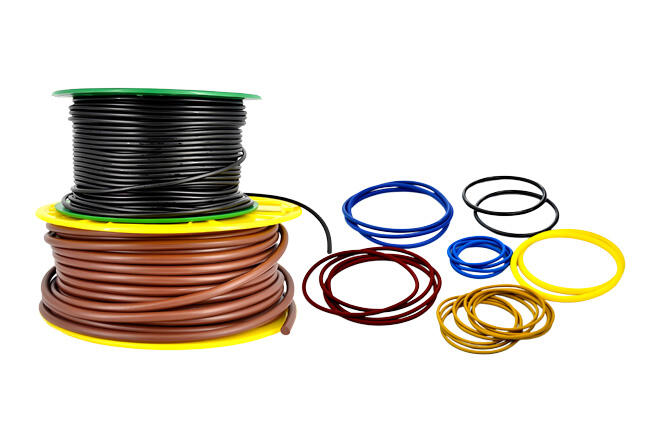Over the years, I’ve lost count of how many times distributors, wholesalers, and even maintenance engineers have asked me the same thing: “What’s the difference between an O-ring and an O-ring cord? Which one should I keep in stock?”
It’s a fair question. At first glance, they look similar, both are round in cross-section, both made from elastomers. But in practice, the choice between the two can affect your inventory strategy, your customer’s downtime, and even your reputation as a supplier. Let me walk you through it the way I usually explain it at trade shows or during factory visits.
O-Rings: The Everyday Standard
Think of O-rings as the “ready-to-go” solution. They’re molded into precise sizes, standardized across the industry, and available in thousands of specifications.
· Stock advantage: If you’re a distributor, you know the drill, common sizes move fast. Automotive repair shops, hydraulic service centers, gearbox rebuilders, they all need them yesterday.
· Applications: Engines, pumps, motors, industrial robots, even household appliances. Anywhere a groove is cut to a standard dimension, an O-ring is the natural fit.
· Ease of use: No cutting, no bonding. Just drop it in the groove, lubricate if needed, and you’re done.
O-Ring Cords: The Flexible Fixer
O-ring cords are a different animal. They come as long spools of rubber cord, same round cross-section, but not closed. You cut the length you need, bond the ends, you’ve got a custom O-ring.
· Large diameters: Picture a wind turbine shaft seal. Nobody keeps a 1.5‑meter O-ring on the shelf. A cord solves that.
· Odd sizes: A chemical plant calls with a flange dimension you’ve never seen before. Instead of saying “lead time six weeks,” you cut a cord and bond it.
· Inventory efficiency: One roll of cord can cover dozens of diameters. That’s a lifesaver for distributors who don’t want to tie up capital in slow-moving stock.
Materials and Craftsmanship
Both O-rings and cords use the same elastomers:
· NBR (Nitrile) for oil resistance in pumps and gearboxes.
· FKM (fluoroelastomer) for high temperature and aggressive chemicals.
· EPDM for water and steam.
· Silicone for low-temperature flexibility and appliances.
The real difference is in the joint. A molded O-ring has no weak point. A cord does, and that joint is where experience matters. Cold bonding is quick and fine for static, low-pressure seals. Hot vulcanization takes longer but gives you a joint that can handle pressure and movement.
Installation Tips
· O-Rings: Don’t overstretch them, don’t twist them, and keep the groove clean. Simple advice, but I’ve seen too many failures from ignoring it.
· O-Ring Cords: Cut square, bond carefully. For large diameters, hot vulcanization is worth the effort. A sloppy joint will come back to haunt you.

FAQ
Q1: Should I stock both?
A: Yes. O-rings for the fast-moving, everyday demand. Cords for emergencies and non-standard jobs.
Q2: Are bonded cords reliable?
A: They can be. For static, low-pressure applications, cold bonding is fine. For dynamic or high-pressure, hot vulcanization is the safer bet.
Q3: How do I avoid after-sales headaches?
A: Work with a supplier who doesn’t just ship rubber but also provides technical guidance. At NQKSF, we often help partners choose the right material and bonding method, which reduces warranty claims and keeps customers loyal.
From my side, what makes NQKSF stand out is not just the product range but the way we support partners:
· Standard parts, fast delivery: Over ten thousand specifications of O-rings, oil seals, and related seals in stock. Urgent orders? We can ship immediately.
· Customized solutions: From material selection and groove design to production and testing, we help create seals that match the exact working conditions.
· Technical empowerment: With more than 30 years in the sealing industry, we don’t just sell parts—we help optimize sealing systems, reduce maintenance costs, and improve equipment reliability.
Why Distributors Trust Us
NQKSF is not just a trading name. We are a manufacturing-based enterprise with recognition as:
· A leader in the sealing industry.
· A company with full model coverage and strong stock availability.
· An exporter to 80+ countries worldwide.
· A long-term partner to global brands.
· Certified as a Provincial Technology Innovation Center, a Specialized and Innovative Enterprise, and a High-Tech Enterprise.
· A front-runner in a specialized industrial cluster.
So, what’s the difference between O-rings and O-ring cords? In simple terms: O-rings are the standardized, off-the-shelf solution. O-ring cords are the flexible, cut-to-fit option when size or urgency demands it.
For distributors and wholesalers, the smart play is to carry both. Let O-rings handle the daily demand, and keep cords as your ace in the hole for non-standard or emergency cases. With NQKSF’s combination of stock, customization, and technical support, you’re not just selling seals—you’re building reliability into your customer’s equipment and trust into your business relationships.
 Hot News
Hot News